
“I am come into my garden, my sister, my spouse: I have gathered my myrrh with my spice; I have eaten my honeycomb with my honey; I have drunk my wine with my milk: eat, O friends; drink, yea, drink abundantly, O beloved.” – Song of Songs 5:1
———
There are gardens a-plenty here – or, at least, Edens of a sort.
Marvin Chan’s Shelter from the storm evokes, at first glance, nothing so much as a cinematic tableau from a surreal tale of horror. A disproportionately outsized pair of hands, held together in prayer or supplication, palm to apprehensive palm, takes centre stage in the foreground. Around it, like a slowly encircling clutch of hungry, predatory beings, are numerous disembodied arms, a coven of succubi creeping, climbing, gesturing and reaching out towards the protagonist of this diabolical drama, which takes place against a backdrop of dense tropical vegetation, a tangled web of shoots, creepers, vines and roots, their botanical morphology here mirroring the sinuous shapes of the ghoulish limbs. A similar iconography is witnessed in Respite. No rest for the wicked and Dark of day: the former features a soot-dark rabbit ensnared in the labyrinthine undergrowth of a towering trunk, towards which a pair of arms are making – like their fellows in the previous painting – indecipherable gesticulations of the hands and fingers. Dark of day boasts a mangrove swamp as its setting of choice, an intertidal terrain of lush flora against which the now familiar motif of contorted limbs is seen, hanging over the dank, waterlogged landscape like the grisly relics of a serial killer’s murderous spree …
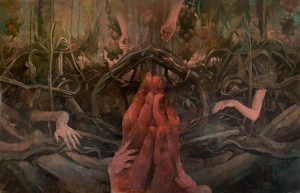
… yet the impulse here is not so much a morbid thanatos, but, rather, its pleasure-driven, libido-led counterpart, eros. The various poses of the disembodied hands – the middle finger outstretched, as if stroking, or with the index finger crooked in the gesture of tickling, or the hand held in cupped fashion, seeming to hold something apart – are derived, according to the artist, from hard-core pornography, and, specifically, from sequences involving female masturbation. The stimulation of the G-spot, the stroking of the vulva and clitoris, the rubbing of the labia – the common repertoire of movements of the hand associated with feminine autoeroticism are encoded here as rebus-esque symbols, sans explicit depiction, of course, of the other half of the equation, the body’s genitalia. The omission is critical. Absent the inclusion of pudenda, the carnal context of these otherwise particular gestures is disrupted, rendering the reference to sexuality and pornography illegible. After all, as has been observed of the hyper-visual drive of hard-core porn: “In contrast to … soft-core indirection, hard core tries not to play peek-a-boo with either its male or its female bodies. It obsessively seeks knowledge, through a voyeuristic record of confessional, involuntary paroxysm, of the “thing” itself.” The scopophobic complex, then, the missing “thing” that results in a deracination of pornography’s “frenzy of the visible”, would seem to suggest more than a mere re-enactment of the voyeuristic act.
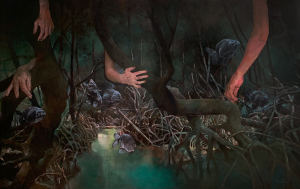
Where might one locate the nexus of meaning here, the cross-currents of various configurations of the gaze? Chan writes of the current exhibition, tellingly titled Serpents in the sun: “[It] broadly borrows its departure from/the biblical banishment of Adam and Eve/from the luxuriously appointed paradise,/framing our propensity to fuck things up.” Biblical iconography and analogies abound: the eponymous reptile appears as a pair of undulating soft sculptures created from a metal weave, with two terracotta hands for heads, the intiatory moment of the postlapsarian realm conjured by the artist. There are numerous skulls, a series of memento mori for a mankind fallen from divine grace (as seen in, say, Seven days). The dark-hued goldfish seen in Dark of day and Respite are evocations of greed – they eat constantly – and forgetfulness, representing, for the artist, “wanderers with insatiable appetites, in search of fulfilment” , while the rabbit in Respite functions as a “symbol of relentless drive”, prey to “lingering hands that arbitrate our judgement.” There is a trio of paintings, Lost. Misdirected, You are here and Row your boat (merrily), each also featuring hands caught in masturbatory motions, poised against paradisiacal topographies of lush, jade-hued foliage and clear, cerulean bodies of water.
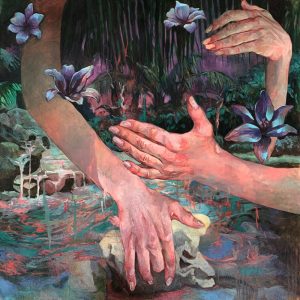
It is in a comparison between the latter triumvirate and the three paintings described earlier in this essay that the various strands of reference here begin to congeal. The Biblical garden as a metaphor for love and sexual expression is a trope that harks back to the Old Testament: the Garden of Eden, of course, is associated with primordial knowledge of sex, sin, and shame, where Adam and Eve, the first man and woman, came to “know”, an act sometimes deployed in Biblical language as an euphemism for carnal activity. The New Testament, too, boasts its own garden of erotic delights; the notoriously amorous and steamy verse of the Song of Songs includes numerous instances of garden imagery as a stand-in for sensual and sensuous enjoyment (the epigraph to this essay is but one example). Elsewhere, a commentator pointedly concludes that “In the world of the Bible, gardens (and vineyards) are places where lovers meet to make love. At the same time, gardens and vineyards often symbolize women and female sexuality … Thus, gardens (and vineyards) symbolize both the female lover and the place of lovemaking.”
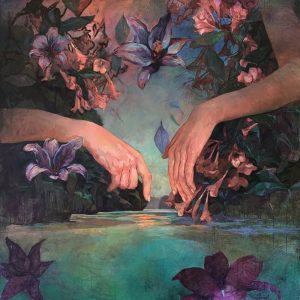
In Chan’s feverish compositions, of course, there are gardens – and then there are other forms of Edenic utopias. If the garden serves as a backdrop for the artist’s psycho-sexual mindscape, his personal morality plays of carnality, redemption (or lack thereof), and religious disappointment, what can we make of the juxtaposition between female sexuality and the tropical jungle – or, in other words, the un-cultivated garden? Gardens, beginning especially in the Renaissance scheme of matters, have long stood as emblems of divine order and logos. They were “theaters for the exercise of virtue, of the dignity, decorum, and humane civility belonging to the humanist ideal of virtù”, and “among much else a “measured and well-ordered model of the universe”, they were ultimately “reminding those who experienced it of the source, the creator, of the natural world: God.” Like their Occidental counterparts, East Asian gardens, too, were microcosms of the universe, of the structure and balance of the cosmos, but also, crucially, of the affinity between Man, his world and his Maker (and also a harbinger of the paradise of Heaven). Here, significantly, the polyphonic multivalence of the garden, emblematic both of cosmic concinnity and female sensuality, finds coherence as a trope.
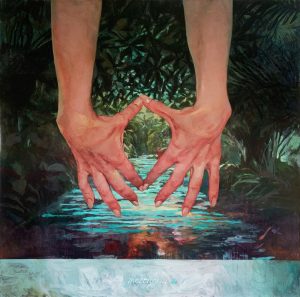
Chan’s depictions of tropical ecosystems – of the towering, thick-trunked trees and overweening vegetation of the rainforests, jungles and intertidal landscapes of Southeast Asia, one of the world’s chief centers of biodiversity – could not be further from the refined premeditation of the garden and its purposive landscaping, of the “humanity’s attempt to carve out an ideal place in nature”. In jettisoning the image of the ordered, cultivated garden and all that it has come to stand for, he tellingly twins it with the motif of female sexuality that is sufficient unto itself: women capable of self-gratification, without the aid of men. The surrender of the symbol of sacred structure and divine disposition here, in other words, dovetails with a vision of carnal fulfilment that is not tied to the lovemaking between man and woman or its natural consequence, reproduction, but rather to deviant forms of sensuality that privileges pleasure. The loss of the cultivated garden and the encroachment of nature in all its wild, untamed character, correlates, in Chan’s baroque, ponderous visual universe, to the consummation of female pleasure and delight that exists purely for itself – a universe sans God, or Adam.
Louise Ho
Curator, Writer
In Radar
